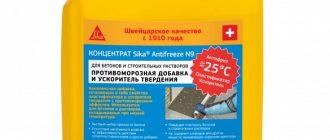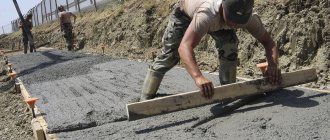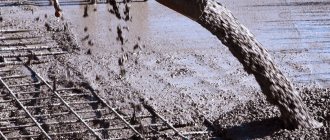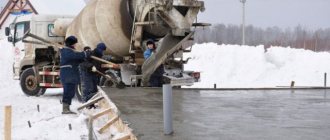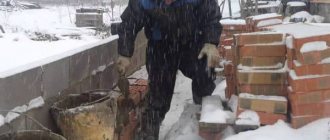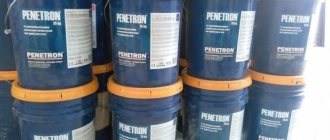- carrying out work on the construction of concrete structures even in cold weather;
- increasing the strength of the building as a result of increasing the adhesion reaction;
- use of the product in industry;
- increasing service life;
- increase in frost resistance, moisture permeability;
- low cost of additives;
- acceleration of hardening of the concrete mixture;
- ease of shaping due to increased mobility;
- unchanged solution structure.
However, builders also highlight disadvantages:
- using more cement;
- toxicity of some substances included in the composition;
- reduction in the declared power and strength of the concrete product;
- increased risk of corrosion.
How to do it yourself?
Before starting work, be sure to study some instructions, the implementation of which leads to an effective result:
- If work is carried out in snowfall, the construction of a protective shelter will be required.
- To prepare the mixture, use warm water and heat the ingredients before cooking.
- The temperature of the mixture after the mixer should be in the range of 15-25 degrees Celsius.
- The amount of salt added depends on the air temperature: from 0 to -5 degrees. - you need 2% of the total mass, and from 6-15 degrees below zero - 4%.
- The characteristics of the concrete mixer and the duration of mixing determine the homogeneity of the solution.
Compliance with the strength requirements for concrete in frosty weather is set out in SNiP 3.03.1-87. According to these requirements, it is not recommended to increase the strength of the structure by more than 20% than stated in the project.
Since chloride salts promote corrosion damage, calcium nitrite nitrate is added. To improve plasticity, urea is added in an amount of 7-10% of the total volume. When preparing frost-resistant additives with your own hands, you also use ammonia water, the amount of which in the solution depends on temperature indicators. When antifreeze is used, they are guided by special calculation tables for various jobs and thermometer readings. But experts recommend buying only this type of impurity.
Rules for adding to the solution
Antifreeze additives are added together with water to sand, cement and plasticizer. Such impurities can only be used at sub-zero temperatures from 15 to 25 degrees. The mass of additives in the mixture takes up 0.02% of the amount of cement. At temperatures lower than expected, add 0.05% more additives with each degree. And we must also not forget about insulating the structure for two days. It is important to remember the safety precautions during work: use gloves, prevent the solution from getting into your eyes and skin, and do not pour it into the sewer, pond or soil.
Concreting technology
Winter concrete must be prepared correctly. It is recommended to add the antifreeze additive to the concrete mixture, having previously dissolved it in water. Laying the mixture is carried out in compliance with the following rules:
To avoid the formation of joints and delaminations, it is necessary to pour the concrete mixture continuously.
- If it is snowing outside, it is recommended to make a shelter over the place where the concrete is poured.
- The solution coming out of the mixer should be in the range of +15 - +20 °C in terms of heat.
- It is recommended to heat the water for preparing the frost-resistant mixture.
- It is recommended to pour the solution continuously to avoid the formation of joints.
If it is not possible to purchase a ready-made additive, chloride salt can be used as an antifreeze additive. However, it is important to keep in mind that the use of this method is only permissible if the concrete structure does not have metal reinforcement.
Types of antifreeze additives in concrete
Concrete is a universal building material that is used for various purposes: from building a house to constructing decorative elements for a personal plot. This is a practical, irreplaceable, economical, convenient material. It has some disadvantages. Exposure to low temperatures is one of the main disadvantages. In cold weather, concrete can change shape, crack, and crumble. The way out of the situation is additives that increase the frost resistance of concrete, allowing construction work to be carried out in the cold season.
Modern antifreeze additives reduce the freezing point of water from 0 to -15 degrees. Additives must be used according to instructions. Uncontrolled use harms the structure and causes undesirable consequences. When it is cold, you need to administer the additive in the correct amount to avoid freezing and undesirable consequences. Frozen plain mixtures are at greater risk.
Briefly about the main thing
Concrete can have different characteristics depending on the brand of cement, the proportions of its components, the correct preparation, and the maturing conditions. These characteristics can be changed at your discretion, if you know that there are special additives for concrete: for strength, for increasing ductility and hardening speed, for resistance to water and low temperatures. The introduction of a small amount of these substances into the solution makes it possible to simplify concrete work and increase the durability of buildings, structures and concrete products.
Ratings 0
Application benefits
- the liquid present in the mixture freezes at lower temperatures than normal, allowing the solution to set;
- the solution becomes more plastic - it is easier to form individual parts of the structure;
- reinforcement in reinforced concrete structures does not oxidize due to corrosion inhibitors present in the additives;
- the water resistance of reinforced concrete increases;
- the mixture becomes strong in a shorter time.
Concrete hardens faster in cold weather - one of the advantages.
After adding the additive to the solution, the mixture becomes more dense due to the saturation of micropores in the concrete with carbonated calcium hydroxide, and it becomes easier to pour it into the mold. The strength of the structure is doubled. 18 hours are enough for the concrete structure to fully harden. Extraction takes place without damaging the integrity of the concrete. High-quality PMDs do not allow the appearance of “salt” on the surface.
The use of antifreeze additives allows you to:
- mix the solution with low-grade concrete, reducing material costs;
- make thinner layers of concrete without risking the quality of the structure (due to increased strength) - the solution is saved;
- concrete will not need treatment with waterproofing agents.
Return to contents
Operating principle
The use of antifreeze additives allows you to pour mortars at temperatures down to -50ºС. They are liquid or powdery formulations added to the mixture. It is important to know that concrete additives added during frost provide only 30% hardening. Final hardening occurs after the monolith is defrosted.
There are several types of antifreeze additives, differing in their principle of action:
- Compositions that lower the freezing point of the liquid, as a result, the process of cement hydration continues, setting proceeds according to the standard mechanism;
- Sulfate-based additives accelerate the compaction of concrete, which releases excess heat, increasing the rate of cement hydration;
- Complex additives increase the solubility and activity of cement laitance, while compounds resulting from the reaction with water reduce its crystallization temperature.
Where is it used?
Antifreeze additives are used in the construction of structures:
- monolithic reinforced concrete;
- with off-design reinforcement, a layer of mortar of more than half a meter;
- prestressed reinforced concrete;
- lightweight concrete;
- plaster mixture;
- paths;
- bridges;
- oil and gas production platforms;
- dams, dikes.
Before adding antifreeze, a test is carried out to determine:
- oxidizing effect on concrete;
- formation of “salts”;
- speed of setting;
- strength.
Return to contents
Some nuances of frame installation
When insulating the under-frame space, it is better to use insulation in slabs, since it has sufficient density for vertical installation and will not sag during operation. If it is not possible to buy exactly this type of thermal insulation material, then you can use the rolled version.
Like any other construction process (for example, arranging lathing for imitation timber), installation of a frame under siding has its own characteristics.
There are some peculiarities in the choice of fasteners. If the wall surface is prepared for the use of various hardware, the most durable fasteners should be preferred.
And, of course, you should not save on the sheathing - after all, the service life of the cladding will depend on how high-quality and durable it is.
Types of additives
High-quality additives for concrete mortar allow it to harden in severe frosts up to 35 degrees. Additives are divided (by chemical effect): superplasticizers, accelerators, mobility regulators that increase frost resistance, modifiers, complex ones.
Plasticizers
Plasticizers - naphthalene sulfate, melamine resin sulfate, organic polyacrylates. They have a plasticizing effect on the solution. Does not require large water consumption. Makes the solution more durable, moisture-proof, concentrated. The mixture is easier to apply - it can be poured in an even layer. Saves energy costs and water. The use of plasticizers allows the mixture to be placed in a mold with high quality, without the formation of voids. Microparticles of concrete solution retain moisture better.
Strengthening
Hardening accelerators - aluminum sulfate, iron sulfate, calcium nitrate, calcium chloride. They act by reducing the hardening time of the solution. As concrete sets, it loses its plasticity, and as it hardens, it gains strength. Their effect is designed for the first three days of drying. During this period, the supplement has the highest level of effectiveness. The class strength of concrete also increases.
Mobility regulators
Substances that allow you to extend the period of use of the finished solution in conditions of increased air temperature and transportation.
Frost-resistant
Frost-resistant additives allow construction work to be carried out at sub-zero temperatures.
- P - calcium carbonate increases the rate of hardening at thirty degrees below zero;
- NC—calcium nitrate;
- M - urea;
- M NK - a mixture of calcium nitrate with urea;
- CA is the result of a combination of hydrochloric acid and calcium. Causes metal oxidation and is not used to create reinforced concrete structures.
Return to contents
Corrosion resistant
Modifiers are used to protect concrete structures from oxidation and frost. Thanks to additives, they last longer.
Complex
Concrete can be improved in different directions by several additives at once. PMD of complex action increases operational characteristics, has a positive effect on reinforcement, and strengthens reinforced concrete structures.
Why is concrete cast at low temperatures?
If temperatures below +5°C are harmful to concrete, why is concrete work carried out in such conditions?
The answer is simple: sometimes there is simply no choice.
There are many regions in Russia where optimal temperature conditions for concreting appear for a very short time. In fact, it is late spring or early autumn. It would be strange to cancel construction work the rest of the year.
But this is not the only reason; Sometimes winter concreting is done deliberately for the following reasons:
- in winter prices for building materials may be lower;
- on soft soils, in some cases, concreting foundations is possible only in winter;
- It is easier for heavy equipment to drive through frozen access roads.
Tips for choosing
When choosing antifreeze additives, they take into account the method, circumstances of operation of the concrete structure, ambient temperature, brand, composition of cement, and quality of the additive. The PMDs used by specialists the most are considered optimal:
- potash (7% concentration) is suitable for Portland cement;
- sodium nitrite;
- sodium chloride is used for rapid hardening modifications.
When choosing PMD, you need to pay attention to the experience, image of the manufacturer, reviews in order to avoid purchasing a low-quality product.
>
How is a frost-resistant additive used in concrete (for frost resistance)
Frost-resistant additives in concrete are special compounds that, in one way or another, can make concrete suitable for work at sub-zero temperatures without losing its basic technical characteristics. Modern manufacturers offer a variety of antifreeze additives that perform certain functions and in one way or another solve the problem of the inability to pour ordinary concrete at temperatures below +5 degrees.
Concrete is a universal building material that is used today in a variety of fields. Pouring various structures and completing elements, constructing buildings and other objects - all this work is carried out year-round, so the ability to use the solution at sub-zero temperatures is very important.
An ordinary solution at temperatures below +5 degrees ceases to set and harden, and even if the reaction takes place, it causes damage to the internal crystalline bonds and a significant deterioration in the properties of the material. Thus, concrete poured in the cold can become covered with cracks, chips, change shape, crumble and deform.
The optimal conditions for proper setting and hardening of the concrete solution are temperatures around +20 degrees and high humidity. If there is a need to work with concrete mixture in cold weather, it is important to use special additives. Features of the use of the compositions are indicated in the instructions, the work is carried out according to the rules specified in GOSTs and SNiPs.
Where is it used?
Any additive to concrete for frost resistance is a real godsend for modern construction. Additives are used in a variety of situations where work needs to be done at low temperatures without compromising quality.
Where are anti-frost additives for concrete used:
- When pouring monolithic reinforced concrete structures and parts of buildings.
- In prestressed reinforced concrete.
- With off-design reinforcement, where the mortar layer should be more than 50 centimeters.
- In light types of concrete.
- For mixing plaster mixtures.
- When pouring paths and various surfaces of private housing construction.
- When performing important structures and structures - bridges, dams, dams, gas and oil production platforms, etc.
Regardless of the scope of application, before starting work with concrete, tests must be carried out to determine the level of strength, setting speed, characteristics of the oxidizing effect on the concrete mixture, the presence of “salts,” etc.
A variety of additives are added to concrete - it all depends on the material, work conditions and future use. All types of additives are added to the solution with water in accordance with the instructions. Then the mixture is thoroughly mixed, wait a certain time and use.
Typically, the consumption of additives per cubic meter of solution depends not so much on the substance as on the average daily ambient temperature. So, at temperatures down to -5, it is recommended to add no more than 2% of the additive by weight of the solution, at -10 degrees 3% is possible, at -15 - a maximum of 4%. If the frosts are very severe, they are calculated individually.
To improve the results, it is recommended to adhere to the following rules: the temperature of the poured solution should be from +15 to +25 degrees, additives are dissolved in heated water, crushed stone and sand are also preheated, but not cement.
Infrared and induction methods
If you are thinking about how to pour concrete in sub-zero temperatures, you can also use the induction method. It is mainly used in crossbars, beams and purlins. This method is not very common due to the complexity of the device. It consists in the fact that the insulated wire creates induction and heats the fittings around which the element is wound.
Warming up using infrared rays is based on the ability of the latter to heat the surface of transparent objects with heat transfer throughout the volume. When using this method, the concrete should be wrapped in a transparent film, which will transmit the rays through itself, preventing the heat from quickly evaporating. The advantage of such heating is that transformers do not need to be used. The method also has a drawback. It is expressed in the inability of infrared radiation to uniformly heat large structures.
If you plan to pour concrete in sub-zero temperatures, you should know that the method described above is only suitable for thin structures. Regardless of what type of electric heating is used, you need to monitor the temperature. If it rises above +50˚C, it will create dangerous conditions. The heating rate (as well as cooling) should not exceed 10 ˚C per hour.
Types of additives
High-quality additives for working at low temperatures allow you to work with concrete in temperatures down to -35 degrees. There are many types of additives - these can be accelerators, plasticizers, mobility regulators, modifiers, complex substances. They can be purchased ready-made or made yourself. The second option is more risky, since the exact recipes and properties of various substances with an antifreeze effect are not precisely known.
Many craftsmen use ordinary salt (sodium chloride) - it lowers the freezing point of the liquid and reduces the critical hardening time of the solution. To prepare such an additive, salt is dissolved in water and added to the mixture. For -5 degrees the concentration is 2% by weight of the solution, -15 - 4%. The disadvantage of this solution is its corrosion activity towards metal, so reinforced concrete structures cannot be filled with such a mixture.
Plasticizers
Organic polyacrylates, melamine resin or naphthalene sulfate are used as plasticizers. These additives have a plasticizing effect on the mixture and do not require large water consumption. The monolith becomes more waterproof, durable, concentrated (dense).
The mixture with the additive is much easier to place and is poured evenly, significantly saving water and energy costs. Thanks to the introduction of plasticizers into the composition, it is possible to accurately place the mixture in molds and eliminate the possibility of voids forming. Microparticles of the mixture retain moisture more effectively.
Strengthening
Such additives for concrete are also called hardening accelerators - the group includes calcium nitrate and chloride, iron and aluminum sulfate. Additives work by reducing the curing time of the mixture. At the moment of setting, concrete loses its plasticity, and during the hardening process it becomes strong.
Mobility regulators
These are special substances that make it possible to extend the period of work with a ready-made solution. They are divided into 2 types: additives that are introduced in minimal volumes and regulate characteristics (0.1-2%) and finely ground alloys (5-20%) to reduce cement consumption and without changing properties.
Features of the use of mobility regulators:
- The most effective are chemical plasticizers and superplasticizers.
- Additives increase the mobility of solutions and reduce water demand.
- Ligatures of the same class can have different effects on the solution.
- Superplasticizers are considered the best, which: increase the construction and technological properties of the mixture, increase the mobility of the solution, and reduce cement consumption.
Frost-resistant
These additives make it possible to carry out work at subzero temperatures without changing the technology or deteriorating the characteristics of the concrete solution.
The main types of frost-resistant additives:
- NC – calcium nitrate, affects the rate of hardening of the solution.
- P – potash, calcium carbonate, which can accelerate the hardening of the solution at -30 degrees.
- M – urea.
- HK is a combination of hydrochloric acid and calcium, which oxidizes metal, and therefore is not used in reinforced concrete.
- M NK is a combination of urea and calcium nitrate.
- NN, NNK – sodium nitrate and calcium nitrite nitrate, which accelerate the hardening process, have an anti-corrosion effect, but are toxic (require the use of personal protective equipment).
Corrosion resistant
These modifiers are used where it is necessary to protect reinforced concrete structures from oxidation, which significantly extends their service life and prevents destruction and the negative effects of external factors.
Complex
There are additives that have several effects on the concrete mixture at once - they can simultaneously have a positive effect on the reinforcement and protect it, improve the performance properties of concrete, and increase the strength characteristics of a reinforced concrete structure.
Video description
Watch a video testing paving slabs made with and without a hydrophobic additive:
Other Supplements
Additives to cement can have other purposes, have a special or complex effect.
- Anti-corrosion additives give concrete resistance to acids and poorly soluble compounds, protect reinforcement and elements of removable and permanent formwork, and other metal structural elements in contact with concrete from rusting.
- Additives that improve the self-compaction of concrete make it possible to create thin-walled products and structures with a large number of reinforcing elements.
- Air-entraining additives slow down the evaporation of moisture from molding products, stimulating complete hydration of the cement.
- Multifunctional chemical additives for concrete have a complex effect and improve several of its characteristics at once.
Complex waterproofing additive Source promindex.ru
